For mobile RAW storage, portable SSD drives are your best bet. They offer fast transfer speeds, durability, and ample capacity for on-the-go photographers. Look for options from reputable brands like Samsung, SanDisk, or Western Digital, considering factors like storage size, read/write speeds, and device compatibility. Cloud storage services like Google Drive or Adobe Creative Cloud provide flexible access but require a reliable internet connection. For Android users, high-capacity microSD cards can expand your phone's storage. Whatever you choose, prioritize rugged designs and security features to protect your valuable RAW files. Exploring these options further will help you find the perfect fit for your workflow.
Understanding Mobile RAW Photography
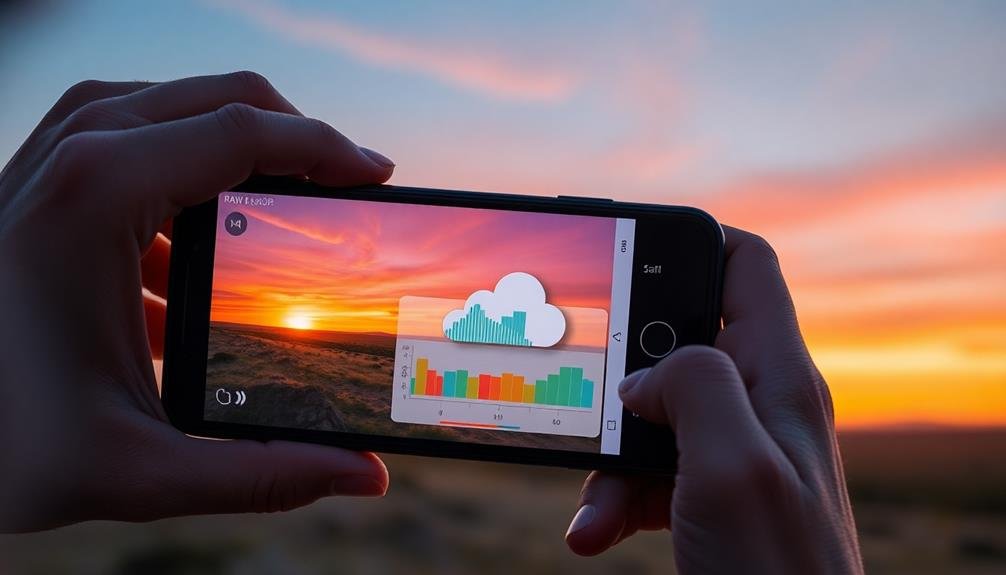
RAW photography on mobile devices has revolutionized the way photographers capture and edit images on the go. When you shoot in RAW, you're preserving all the data captured by your phone's image sensor, giving you greater flexibility in post-processing.
Unlike JPEG files, which compress and discard some image data, RAW files retain every bit of information, allowing for more extensive adjustments to exposure, white balance, and color.
Mobile RAW files typically come in formats like DNG (Digital Negative) or device-specific formats. They're larger than JPEGs, often 2-3 times the size, which means you'll need more storage space. However, the trade-off is worth it for the enhanced image quality and editing potential.
To shoot in RAW on your mobile device, you'll need a phone that supports it and a compatible camera app. Many high-end smartphones now offer native RAW capture, while others may require third-party apps.
When editing RAW files on your mobile device, you'll need specialized apps that can handle these data-rich files, such as Adobe Lightroom Mobile or Snapseed.
Portable SSD Drives

When it comes to storing your mobile RAW files, portable SSD drives are a game-changer. These compact devices offer lightning-fast transfer speeds, durability, and ample storage capacity. You'll appreciate their reliability and convenience when working in the field or traveling.
Portable SSDs outperform traditional hard drives in several key areas. They're more resistant to shock and vibration, making them ideal for on-the-go photographers. You'll find that they consume less power, which is vital when you're relying on battery-powered devices.
Plus, their smaller size means you can easily slip one into your camera bag or pocket.
When choosing a portable SSD for your mobile RAW storage needs, consider these factors:
- Storage capacity: Verify it's sufficient for your workflow
- Read/write speeds: Faster speeds mean quicker file transfers
- Compatibility: Check if it works with your mobile devices and cameras
Many photographers prefer portable SSDs from reputable brands like Samsung, SanDisk, and Western Digital. These drives often come with additional features such as password protection and encryption, keeping your valuable RAW files secure.
Cloud Storage Options

Cloud storage's versatility makes it an attractive option for photographers seeking mobile RAW file storage solutions. With cloud services, you can access your files from anywhere with an internet connection, making it ideal for on-the-go editing and sharing.
Popular cloud storage options for photographers include Google Drive, Dropbox, and Adobe Creative Cloud. These services offer varying amounts of storage space and pricing plans to suit different needs. Some, like Adobe Creative Cloud, cater specifically to photographers with integrated editing tools and file management features.
When considering cloud storage, evaluate factors such as upload and download speeds, security measures, and compatibility with your existing workflow. Look for services that offer automatic backup and syncing across devices to guarantee your RAW files are always up-to-date and accessible.
Keep in mind that cloud storage requires a reliable internet connection for peak performance. If you're working in remote areas with limited connectivity, you may need to combine cloud storage with local storage options for a more robust solution.
Additionally, consider the long-term costs of subscription-based cloud services compared to one-time investments in physical storage devices.
Memory Cards for Smartphones
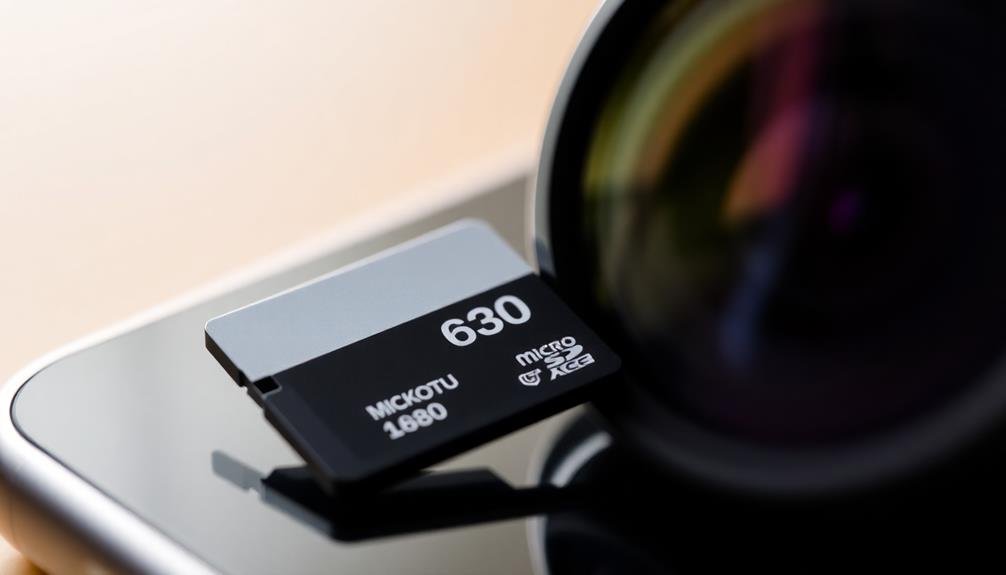
Expanding your smartphone's storage capacity is essential for photographers who shoot RAW files on their mobile devices. While not all smartphones support expandable storage, many Android devices allow you to insert microSD cards for additional space.
When choosing a memory card for your smartphone, consider factors like capacity, speed, and reliability. Look for cards with high storage capacities, such as 128GB, 256GB, or even 512GB, to accommodate large RAW files.
Verify the card's speed class matches your device's capabilities, with UHS-I or UHS-II cards offering faster read and write speeds for smoother performance when handling RAW files.
When selecting a memory card for mobile RAW storage, prioritize these features:
- Durability: Choose cards that are water-resistant, temperature-proof, and shockproof.
- Brand reputation: Stick to well-known brands like SanDisk, Samsung, or Lexar.
- Warranty: Opt for cards with longer warranty periods for added peace of mind.
Remember to regularly backup your RAW files from your memory card to a more permanent storage solution, such as an external hard drive or cloud service, to protect your valuable images from potential card failure or loss.
Wireless External Hard Drives
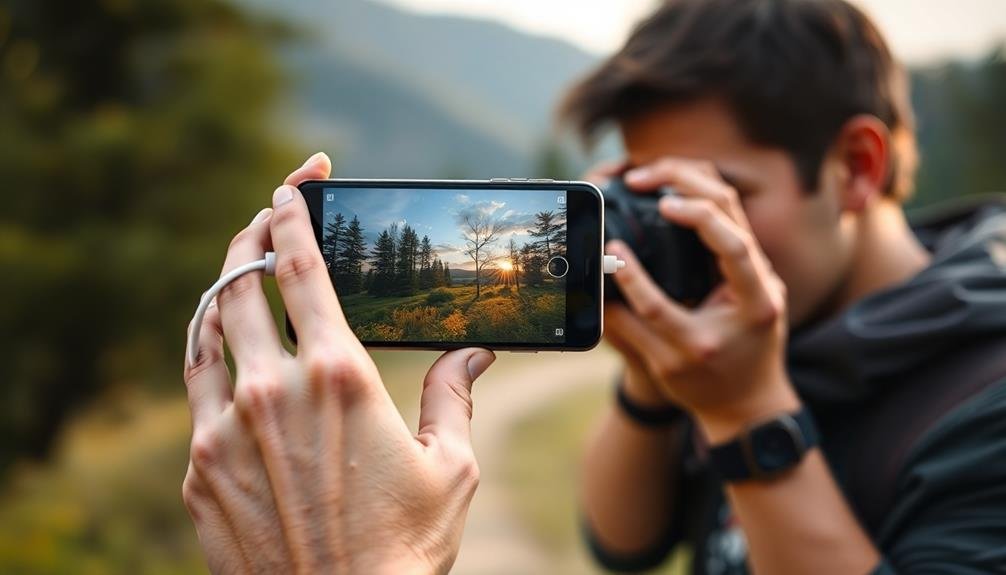
Photographers on the go can benefit greatly from wireless external hard drives for storing and accessing RAW files. These devices offer a portable solution for backing up and expanding your storage capacity without the need for cables or a computer.
When choosing a wireless external hard drive, consider its storage capacity, transfer speed, and battery life. Look for models with at least 1TB of space to accommodate large RAW files. Opt for drives with USB 3.0 or faster connections for quick data transfer when you're not using the wireless feature.
Many wireless drives come with companion apps that allow you to manage files, view images, and even share them directly from your mobile device. Some models offer built-in SD card readers, enabling you to back up your memory cards without a computer.
Pay attention to the drive's durability, especially if you're working in challenging environments. Look for rugged options with shock-resistant casings and water resistance.
While wireless external hard drives offer convenience, they may have slower transfer speeds compared to wired alternatives. Consider your workflow needs and whether the trade-off between wireless functionality and speed is worthwhile for your photography style.
NAS Systems for Photographers
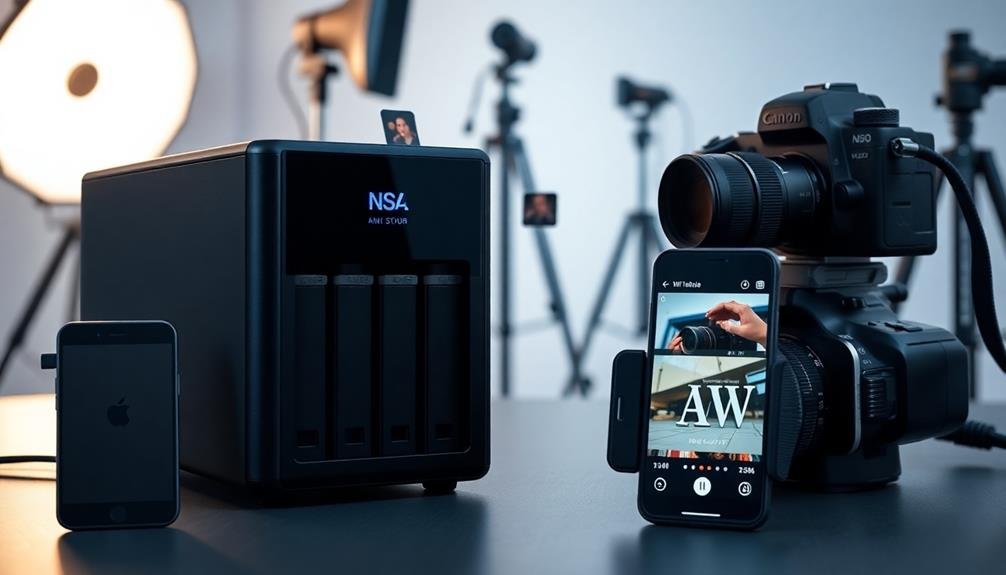
NAS systems offer photographers a powerful solution for storing and accessing their RAW files remotely.
You'll benefit from centralized storage, automatic backups, and the ability to access your files from anywhere with an internet connection.
Some top NAS options for photographers include Synology DiskStation models, QNAP TS series, and Western Digital My Cloud Pro series.
Benefits of NAS Systems
A powerhouse of storage and accessibility, Network Attached Storage (NAS) systems offer photographers a wealth of benefits for managing their RAW files. With a NAS, you'll have a centralized storage solution that's accessible from multiple devices, guaranteeing your photos are always within reach.
This setup allows you to work on your images from any computer or mobile device connected to your network, streamlining your workflow and boosting productivity.
NAS systems provide robust data protection through built-in redundancy features like RAID configurations. This means your precious RAW files are safeguarded against hardware failures, giving you peace of mind.
Additionally, many NAS devices offer automatic backup options, further enhancing your data security.
The scalability of NAS systems is another significant advantage. As your photo library grows, you can easily expand your storage capacity by adding more drives or upgrading to larger ones.
This flexibility guarantees your storage solution can keep pace with your evolving needs.
Key benefits of NAS systems for photographers include:
- Centralized storage and accessibility
- Enhanced data protection and backup options
- Scalability to accommodate growing photo libraries
Top NAS for Photographers
Now that we've explored the advantages of NAS systems, let's examine some top-tier options tailored specifically for photographers.
- Synology DS920+: This 4-bay NAS offers excellent performance and scalability. It's equipped with an Intel Celeron processor and supports up to 8GB of RAM, making it ideal for handling large RAW files and photo libraries.
- QNAP TS-453D: With its powerful Intel Celeron J4125 processor and upgradeable RAM, this NAS provides smooth photo management and quick file transfers. It also features dual 2.5GbE ports for faster network speeds.
- Asustor AS5304T: This NAS boasts a quad-core processor and up to 8GB of RAM, perfect for demanding photography workflows. It offers multiple backup options and supports various third-party apps.
- Western Digital My Cloud Pro Series PR4100: Designed with creatives in mind, this NAS comes preconfigured and offers easy setup. It features dual Ethernet ports and supports up to 40TB of storage.
- TerraMaster F5-422: This cost-effective option provides 10GbE networking and can handle large photo libraries efficiently. It supports up to 80TB of storage and offers various RAID configurations for data protection.
Mobile Apps for RAW Management

When managing RAW files on the go, you'll find mobile apps that offer both cloud-based storage solutions and local device management.
These apps allow you to store, organize, and edit your RAW files directly on your smartphone or tablet, giving you flexibility in your workflow.
You can also sync your files across multiple devices, ensuring you have access to your entire photo library wherever you are.
Cloud-Based Storage Solutions
Cloud-based storage solutions have revolutionized how photographers manage their RAW files on the go. These services offer seamless integration with your mobile devices, allowing you to upload, access, and share your RAW files from anywhere with an internet connection. Popular options like Google Drive, Dropbox, and iCloud provide ample storage space and automatic syncing across multiple devices.
When choosing a cloud-based solution for your RAW files, consider the following factors:
- Storage capacity and pricing tiers
- File transfer speeds and bandwidth limits
- Integration with RAW editing software
Many cloud services offer specialized features for photographers, such as automatic backup of your camera roll and the ability to preview RAW files directly in the app. Some even provide AI-powered organization tools to help you sort and tag your images efficiently.
It's important to note that while cloud storage offers convenience, it's not a replacement for local backups. Always maintain multiple copies of your important RAW files, including at least one offline backup.
Local Device Management
While cloud storage offers flexibility, local device management through mobile apps provides photographers with immediate access to their RAW files, even without an internet connection. These apps allow you to organize, edit, and share your RAW images directly from your mobile device.
Popular apps like Lightroom Mobile and Capture One for iPad offer robust RAW processing capabilities. They enable you to adjust exposure, color, and other settings on the go. You'll find features like star ratings, color labels, and keywords to help you sort and categorize your images efficiently.
Some apps, such as PhotoManager Pro and Mylio, focus on file organization and backup. They'll help you create folders, tag images, and sync across devices. This guarantees your RAW files are well-organized and easily accessible.
When choosing a local device management app, consider factors like storage capacity, processing power, and compatibility with your camera's RAW format. Look for apps that offer seamless integration with your existing workflow and desktop editing software.
Remember to regularly back up your locally stored RAW files to prevent data loss. Many apps offer automatic backup options to external drives or cloud services, giving you peace of mind while managing your images on the go.
Syncing Across Devices
Seamless syncing across devices is essential for photographers who need to access and manage their RAW files on the go. Mobile apps designed for RAW management offer powerful tools to keep your workflow smooth and efficient.
These apps allow you to view, edit, and organize your RAW files across multiple devices, ensuring you're always working with the most up-to-date versions of your images.
When choosing a mobile app for RAW management, look for features that support automatic syncing and cloud storage integration. This way, you'll have instant access to your entire photo library, regardless of which device you're using.
Many apps also offer offline capabilities, allowing you to work on your images even without an internet connection.
Consider these key factors when selecting a RAW management app:
- Compatibility with your preferred cloud storage service
- Speed and reliability of syncing process
- User interface and ease of use across different devices
Comparing Storage Capacities

When it comes to mobile RAW storage, capacity is king. You'll want to evaluate how much space you need for your RAW files, as these can quickly consume storage. Most portable drives for photographers come in capacities ranging from 500GB to 4TB or more.
For casual shooters, a 1TB drive might suffice, allowing storage of about 20,000 RAW files from a 24MP camera. However, if you're a professional or shoot high-resolution images, you'll likely need 2TB or more. Remember, it's better to have extra space than to run out mid-shoot.
Some devices offer expandable storage through SD card slots or additional drive bays. This flexibility can be invaluable as your needs grow.
Cloud storage is another option, but it requires a reliable internet connection and may have recurring costs.
When comparing capacities, don't just look at the numbers. Evaluate the physical size of the device, as larger capacities often mean bulkier drives.
Balance your storage needs with portability to find the right fit for your workflow. Finally, factor in future needs – your storage requirements will likely increase over time.
Speed and Performance Considerations
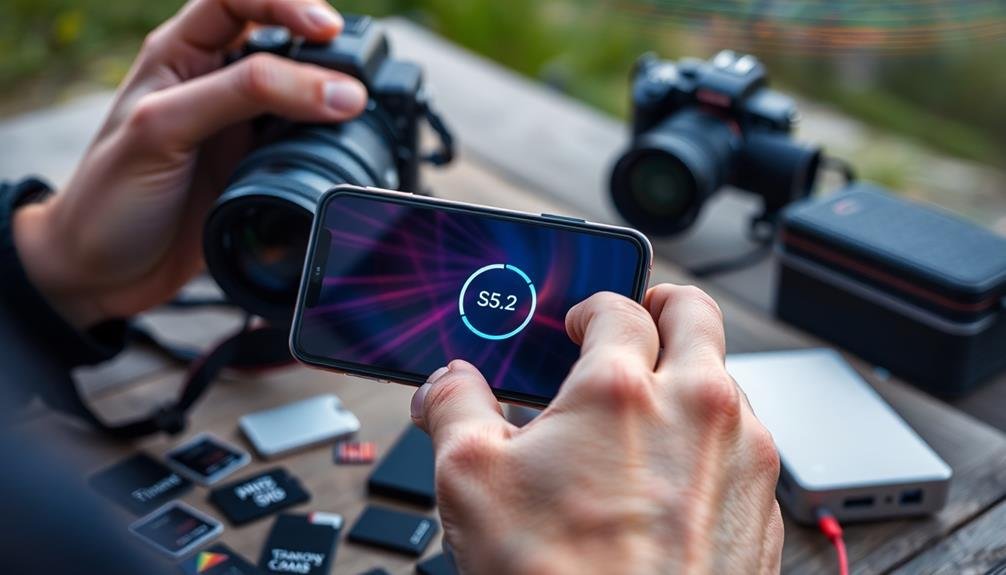
Storage capacity isn't the only factor to contemplate when choosing mobile RAW storage. Speed and performance play vital roles in your workflow efficiency. When you're out shooting, you'll want a storage solution that can keep up with your camera's burst mode and quickly transfer files.
Look for devices with fast read and write speeds. SSDs generally outperform HDDs in this regard, offering quicker data access and transfer times. USB 3.1 or Thunderbolt 3 interfaces will provide the fastest connection speeds between your storage device and computer or camera.
Consider these key performance factors:
- Read/write speeds (measured in MB/s)
- Random access times
- Cache size and type
Ruggedized options can withstand the rigors of outdoor shoots, protecting your valuable RAW files from drops, dust, and moisture. Some devices offer built-in card readers, eliminating the need for separate adapters and streamlining your workflow.
Remember that faster performance often comes at a higher price point. Balance your budget with your speed requirements to find the best mobile RAW storage solution for your needs.
Regular backups are essential, regardless of the device you choose, to safeguard your precious images.
Security Features for RAW Files
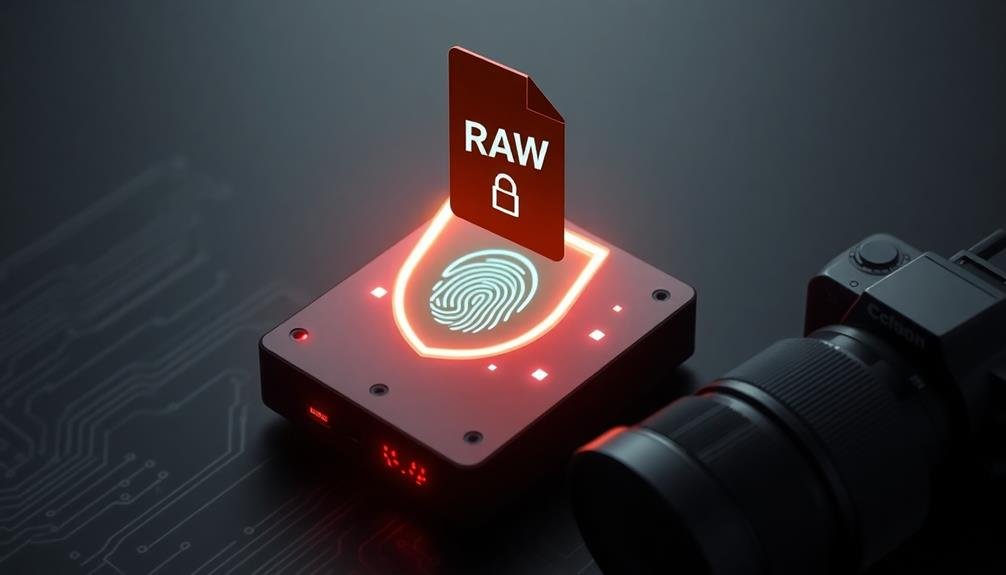
Protecting your precious RAW files is paramount for photographers. When choosing mobile RAW storage, you'll want to prioritize devices with robust security features. Look for options that offer hardware encryption, such as AES 256-bit, to safeguard your files from unauthorized access.
Many high-end storage solutions include built-in fingerprint sensors or passcode protection, adding an extra layer of security. Consider devices with automatic backup features that sync your RAW files to cloud storage or a secondary device. This guarantees you'll have a copy of your work even if your primary storage is lost or damaged.
Some mobile storage solutions offer rugged designs with water and dust resistance, protecting your files from environmental hazards. Don't overlook the importance of software security. Choose storage options that are compatible with trusted antivirus and malware protection programs.
Look for devices that receive regular firmware updates to patch potential vulnerabilities. Additionally, some mobile RAW storage solutions offer remote wipe capabilities, allowing you to erase your data if the device is lost or stolen. By prioritizing these security features, you'll guarantee your valuable RAW files remain safe and protected while on the go.
Frequently Asked Questions
Can I Edit RAW Files Directly From Mobile Storage Devices?
Yes, you can edit RAW files directly from mobile storage devices. Many photo editing apps now support RAW processing on smartphones and tablets. You'll need sufficient device storage and a compatible app to work with your camera's RAW format.
How Do Different Storage Options Affect Battery Life on Mobile Devices?
You'll find that different storage options can impact your device's battery life. Internal storage is generally most efficient. External drives and cloud storage may drain more power due to connectivity and data transfer requirements.
Are There Any Compatibility Issues Between RAW Storage Devices and Smartphone Models?
You'll find that compatibility issues can arise between RAW storage devices and smartphones. It's essential to check your device's specs and the storage unit's requirements. Some models may not support certain drives or file systems.
What's the Best Way to Organize RAW Files Across Multiple Storage Options?
To organize RAW files across multiple storage options, you'll want to use a consistent folder structure. Sort by date, location, or project. Use metadata and tags for easy searching. Don't forget to back up regularly across all devices.
How Does Temperature and Humidity Affect Mobile RAW Storage Performance?
Temperature and humidity can greatly impact your mobile RAW storage. You'll want to keep devices cool and dry to prevent data corruption. Extreme heat or moisture can reduce performance and lifespan. Always store in controlled environments when possible.
In Summary
You've got plenty of options for mobile RAW storage as a photographer. Whether you opt for portable SSDs, cloud services, high-capacity memory cards, or wireless hard drives, choose what fits your workflow best. Don't forget to take into account storage capacity, transfer speeds, and security features. Remember, the right solution will keep your precious RAW files safe and accessible while you're on the go. Experiment with different options to find your perfect match.

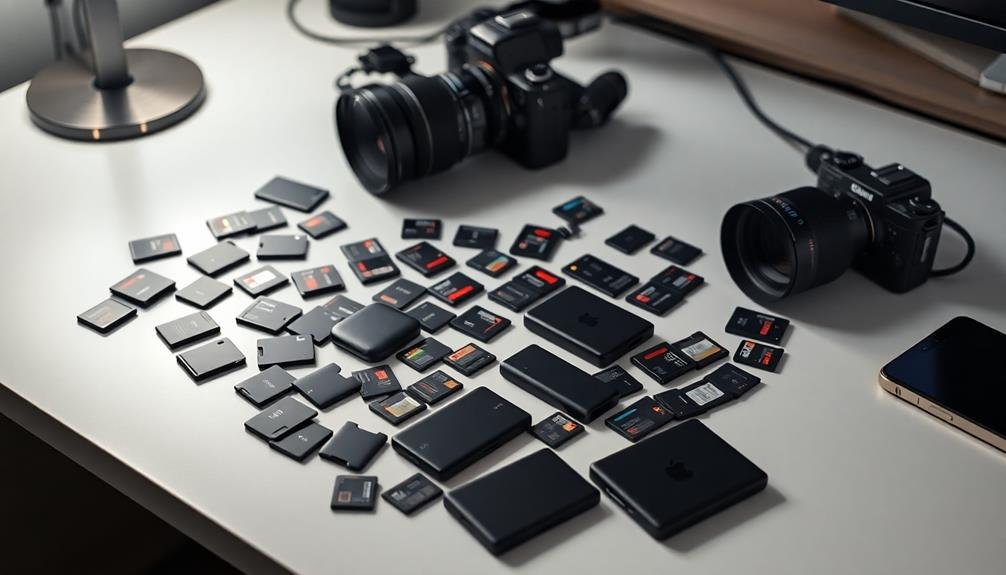



Leave a Reply